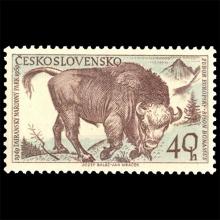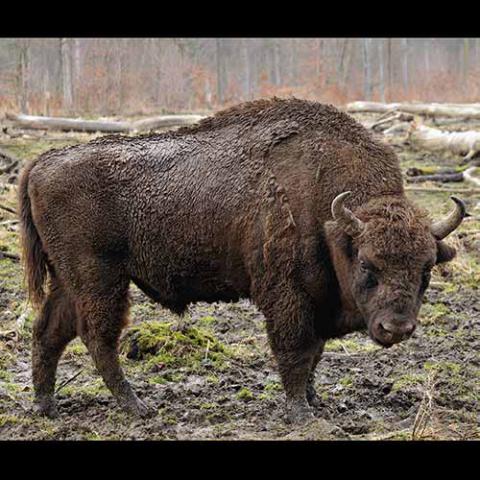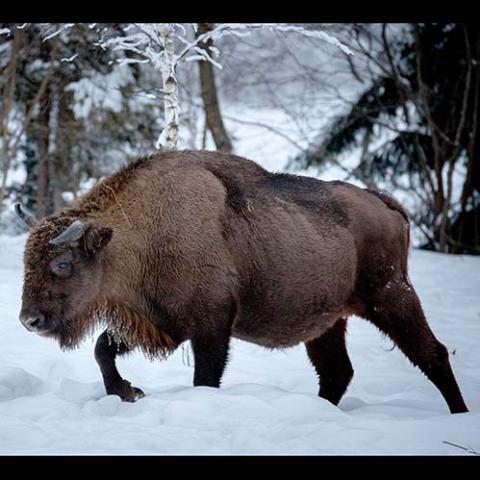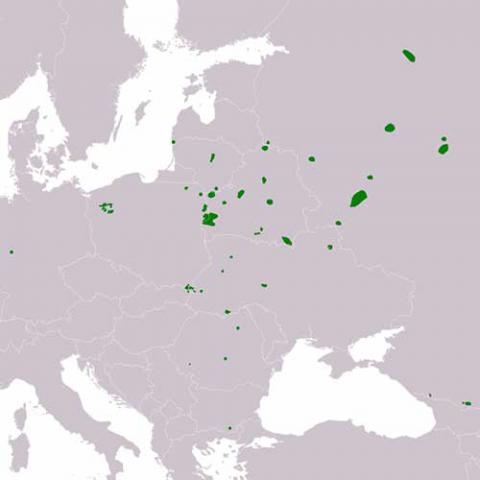NAMES
TAXONOMY
Czechoslovakia
Issued:
Stamp:
Bison bonasus
Czechoslovakia
Issued:
Stamp:
Bison bonasus
Czechoslovakia
Issued:
Stamp:
Bison bonasus
Genus species (Animalia): Bison bonasus
The European bison (Bison bonasus) or the European wood bison, also known as the wisent (/ˈviːzənt/ or /ˈwiːzənt/), or the zubr (/zuːbər/), is a European species of bison. It is one of two extant species of bison, alongside the American bison. The European bison is the heaviest wild land animal in Europe and individuals in the past may have been even larger than modern animals. During late antiquity and the Middle Ages, bison became extinct in much of Europe and Asia, surviving into the 20th century only in northern-central Europe and the northern Caucasus Mountains. During the early years of the 20th century bison were hunted to extinction in the wild. The species — now numbering several thousand and returned to the wild by captive breeding programs — is no longer in immediate danger of extinction, but remains absent from most of its historical range. It is not to be confused with the aurochs (Bos primigenius), the extinct ancestor of domestic cattle, with which it once co-existed.
Besides humans, bison have few predators. In the 19th century, there were scattered reports of wolves, bears, Asiatic lions, and Caspian tigers hunting bison. In the past, especially during the Middle Ages, bison were commonly killed for their hide and meat, and to produce drinking horns. European bison were hunted to extinction in the wild in the early 20th century, with the last wild animals of the B. b. bonasus subspecies being shot in the Białowieża Forest (on the Belarus–Poland border) in 1921, and the last of the Caucasian wisent subspecies (B. b. caucasicus) in the north-western Caucasus in 1927. The Carpathian wisent (B. b. hungarorum) had been hunted to extinction in the mid-1800s. The Białowieża or lowland European bison was kept alive in captivity, and has since been reintroduced into several countries in Europe. In 1996, the International Union for Conservation of Nature classified the European bison as an endangered species, no longer extinct in the wild. Its status has improved since then, changing to vulnerable and later to near threatened.
European bison were first scientifically described by Carl Linnaeus in 1758. Some later descriptions treat the European bison as conspecific with the American bison. Three subspecies of European bison existed in the recent past, but only one, the nominate subspecies (B. b. bonasus), survives today. Analysis of mitochondrial genomes and nuclear DNA revealed that the wisent is theoretically the descendant of a species which arose as a result of hybridisation between the extinct steppe bison (Bison priscus) and the ancestors of the aurochs (Bos primigenius), since their genetic material contains up to 10% aurochs DNA sequences; the possible hybrid, now extinct, is referred to informally as the Higgs bison, a pun in reference to the Higgs boson. Alternatively, the Pleistocene woodland bison has been suggested as the ancestor to the species.
The European bison is one of the national animals of Poland and Belarus.
Etymology
The ancient Greeks and ancient Romans were the first to name bison as such; the 2nd-century AD authors Pausanias and Oppian referred to them as Hellenistic Greek: βίσων, romanized: bisōn. Earlier, in the 4th century BC, during the Hellenistic period, Aristotle referred to bison as βόνασος, bónasos. He also noted that the Paeonians called it μόναπος (monapos). Claudius Aelianus, writing in the late 2nd or early 3rd centuries AD, also referred to the species as βόνασος, and both Pliny the Elder's Natural History and Gaius Julius Solinus used Latin: bĭson and bonāsus. Both Martial and Seneca the Younger mention bison (pl. bisontes). Later Latin spellings of the term included visontes, vesontes, and bissontes.
John Trevisa is the earliest author cited by the Oxford English Dictionary as using, in his 1398 translation of Bartholomeus Anglicus's De proprietatibus rerum, the Latin plural bisontes in English, as "bysontes" (Middle English: byſontes and bysountes). Philemon Holland's 1601 translation of Pliny's Natural History, referred to "bisontes". The marginalia of the King James Version gives "bison" as a gloss for the Biblical animal called the "pygarg" mentioned in the Book of Deuteronomy. Randle Cotgrave's 1611 French–English dictionary notes that French: bison was already in use, and it may have influenced the word's adoption into English, which may alternatively be directly borrowed from Latin. John Minsheu's 1617 lexicon, Ductor in linguas, gives a definition for Bíson (Early Modern English: "a wilde oxe, great eied, broad-faced, that will neuer be tamed").
In the 18th century, the name of the European animal was applied to the closely related American bison (initially in Latin in 1693, by John Ray) and the Indian bison (the gaur, Bos gaurus). Historically, the word was also applied to Indian domestic cattle, the zebu (B. indicus or B. primigenius indicus). Because of the scarcity of the European bison, the word "bison" was most familiar in relation to the American species.
By the time of the adoption of "bison" into Early Modern English, the early medieval English name for the species had long been obsolete: the Old English: wesend had descended from Proto-Germanic: *wisand, *wisund and was related to Old Norse: vísundr. The word "wisent" was then borrowed in the 19th century from modern German: Wisent [ˈviːzɛnt], itself related to Old High German: wisunt, wisent, wisint, and to Middle High German: wisant, wisent, wisen, and ultimately, like the Old English name, from Proto-Germanic. The Proto-Germanic root: *wis-, also found in weasel, originally referred to the animal's musk.
The word "zubr" in English is a borrowing from Polish: żubr [ʐubr], previously also used to denote one race of the European bison. The Polish żubr is similar to the word for the European bison in other modern Slavic languages, such as Upper Sorbian: žubr or Russian: зубр. The noun for the European bison in all living Slavonic tongues is thought to be derived from Proto-Slavic: *zǫbrъ ~ *izǫbrъ, which itself possibly comes from Proto-Indo-European: *ǵómbʰ- for tooth, horn, or peg.
Reference: Wikipedia




